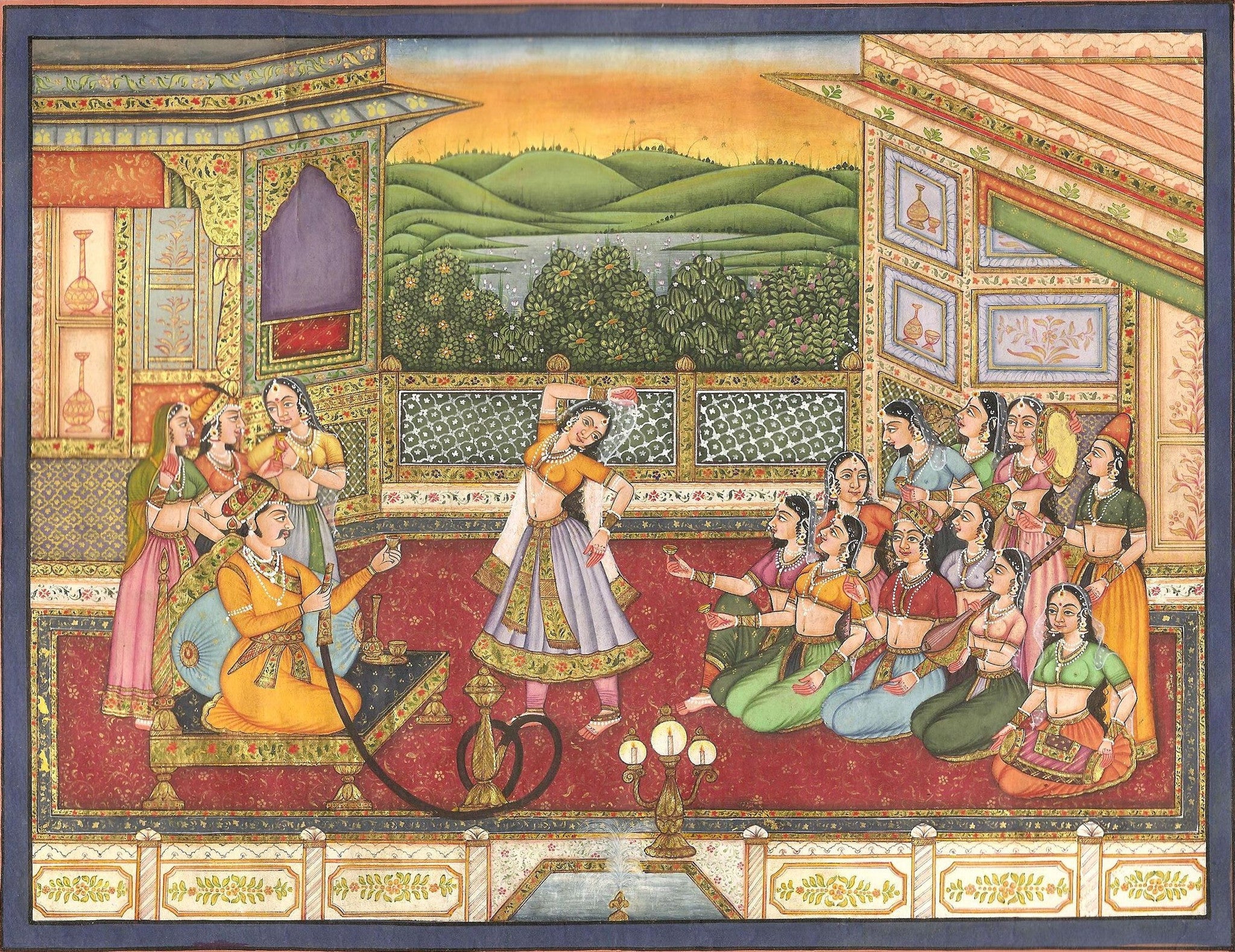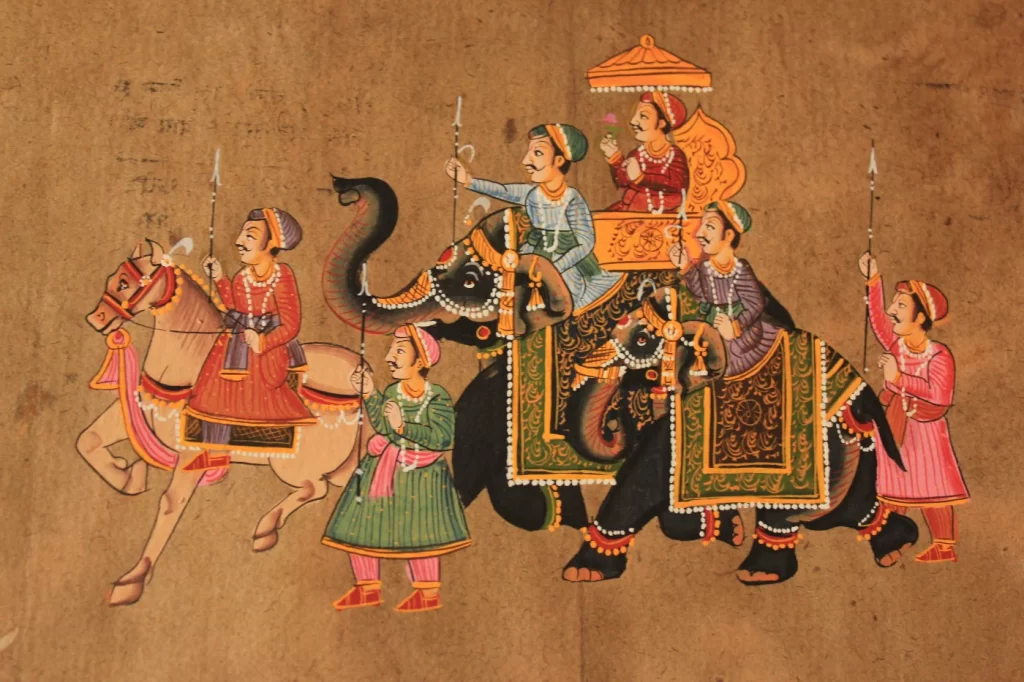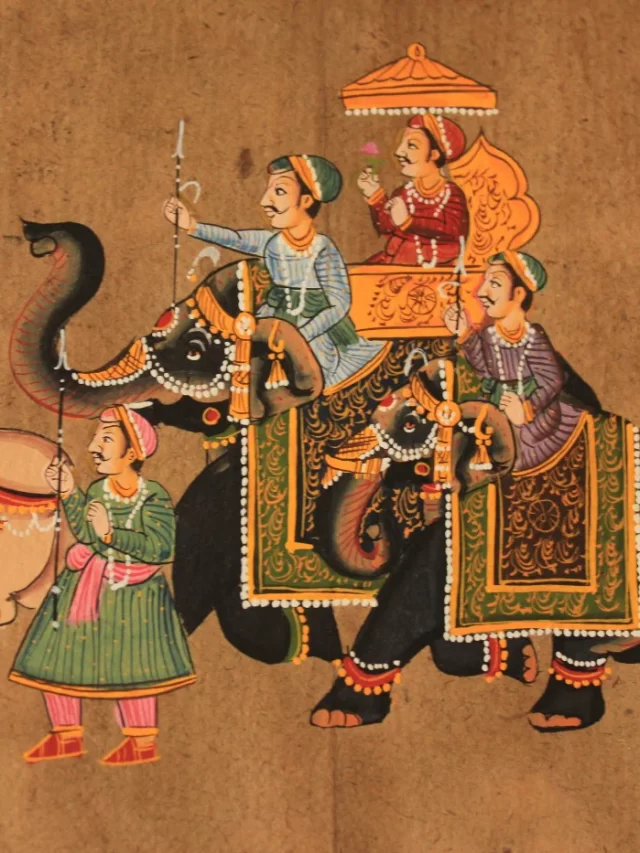Introduction
Rajput painting, a distinguished art form originating from the Rajputana kingdoms of medieval India, encompasses a rich cultural heritage and artistic expression. These paintings, often characterised by their intricate details and vibrant colours, serve as visual narratives of the illustrious Rajput dynasties, capturing the essence of their opulent lifestyle, valorous deeds, and timeless traditions. Miniature paintings, a hallmark of Mughal and Rajput art, intricately depict scenes from the lives of both Mughals and Rajputs, offering a glimpse into their royal courts, battles, and festivities. These miniature marvels, crafted with meticulous precision and exquisite craftsmanship, transcend mere artistic representation to become historical archives of bygone eras.
Rajput miniature artwork, characterised by its delicate brushwork and intricate detailing, showcases scenes from mythological tales, epic battles, and courtly affairs. These miniatures, though small in size, exude a grandeur that belies their dimensions, offering viewers a window into the splendour of Rajputana’s golden age. Paintings illustrating the lives of Rajput queens further enrich the tapestry of Rajput art, highlighting the influential role played by women in Rajput society. These artworks pay homage to the strength, resilience, and grace of Rajput queens, portraying them as pillars of support and symbols of dignity.
Rajput Painting: A Glorious Tradition
Rajput painting, also known as Rajasthani painting, is a distinguished style of Indian miniature art that flourished under the royal patronage of the Rajput rulers in the medieval era. These exquisite paintings reflect the opulence and grandeur of Rajput courts, showcasing scenes of courtly life, royal portraits, and mythological narratives.
Miniature Paintings of Mughals and Rajputs: A Fusion of Cultures
The Mughal influence on Rajput paintings is undeniable, as evidenced by the fusion of artistic styles and themes. Miniature paintings of Mughals and Rajputs depict scenes of imperial splendour, battles, and courtly ceremonies, blending elements of both cultures to create visually stunning artworks that transcend boundaries.

Rajasthani Rajput Woman Painting: Celebrating Feminine Grace
Rajput paintings of Rajasthani Rajput women, shows their beauty, grace, and sophistication. These women are depicted with a regal aura, often wearing intricately embroidered sarees or lehengas, embellished with precious gemstones and gold threadwork. Their jewellry, from ornate necklaces to elaborate earrings, is a testament to the skill of Rajasthani artisans and the wealth of Rajputana’s royalty. Beyond their physical adornments, these paintings capture the essence of their inner strength, dignity, and resilience. They are often depicted in settings that highlight their multifaceted roles within society, such as courtly affairs, religious rituals, or leisure. Rajput paintings serve as cultural artefacts that not only celebrate the beauty and grace of these women but also provide valuable insights into societal norms, values, and traditions of Rajputana. Their influence and contributions continue to resonate through the annals of history.
Rajput Princess Paintings: Elegance and Royalty Personified
Rajput princess paintings epitomise elegance and royalty, portraying princesses adorned in lavish attire and adorned with jewels. These artworks serve as a testament to the esteemed status of Rajput women in society, showcasing their grace and dignity in exquisite detail.

Royal Rajput Painting: A Glimpse into Courtly Life
The lavish way of life and magnificence of Rajput nobles are depicted in the rich weaving of paintings known as Royal Rajput paintings. Viewers are transported to a bygone era where courtly gatherings, hunting expeditions, and regal processions were usual by these paintings, which are frequently portrayed with elaborate brushwork. One famous illustration is “Maharaja Sawai Jai Singh II’s portrait,” in which the king is encircled by courtiers and bodyguards while perched on his throne. Another painting, “The Royal Hunt,” shows a Rajput monarch leading a hunting journey and highlights the king’s skill in both hunting and leisure activities. A visual record of the pomp and circumstance surrounding the life of Rajput aristocracy is also provided by royal processions, such as the great procession held to celebrate a royal wedding.

Rajput Miniature Paintings: Treasures of Heritage
Rajput miniature paintings are revered as treasures of Indian heritage, renowned for their intricate details, vibrant colours, and delicate brushwork. These miniature marvels often depict scenes from Hindu epics, Rajput legends, and historical events, showcasing the artistic prowess and cultural richness of the Rajput dynasties.

Rajput Queen Paintings: Splendour and Majesty
Rajput queen paintings exude splendour and majesty, capturing the grace and dignity of Rajput queens in all their glory. These artworks pay homage to the influential role of Rajput queens in shaping the destiny of their kingdoms, portraying them as symbols of strength, beauty, and resilience.
Old Rajput Painting: Preserving Heritage for Posterity
Old Rajput paintings hold a special place in the annals of art history, serving as precious relics of a bygone era. These antique artworks provide a window into the cultural heritage and artistic legacy of the Rajput dynasties, preserving their rich traditions and timeless beauty for posterity.
Rajput Princess Painting: A Symbol of Tradition and Beauty
Rajput princess paintings stand as enduring symbols of tradition and beauty, capturing the essence of Rajput culture and heritage. These enchanting artworks continue to inspire awe and admiration, reminding us of the indelible mark left by Rajput artists on the canvas of Indian art.






